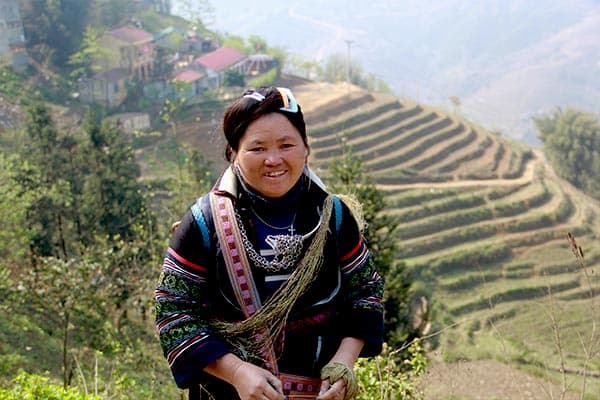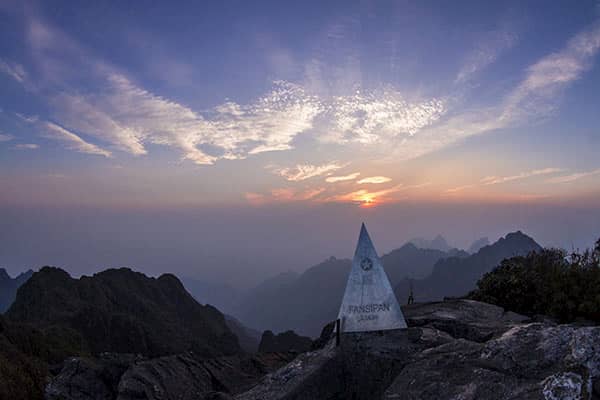SAPA - NORTHERN VIETNAM
IN THE HEART OF THE RICE TERRACES AND ETHNIC MINORITIES OF VIETNAM
Sapa
is a city located in the North of Vietnam, capital of the district of the same
name, in the province of Lào Cai, near China. Sapa is characterized by the
presence of many ethnic minorities in Vietnam, as well as an exceptional
natural landscape.
History of Sapa
The city of Sapa was born in 1903, when cartographers from the Geography Service of Indochina discovered the region. This discovery is part of a colonial project launched in 1897 to map and establish statistical surveys in mountainous regions. The French will thus collect information on the region and its climate, geography, fauna and flora. Sapa is beginning to be known for its pleasant climate and incredible landscapes.
A health resort was built in 1909, followed by a tourist office in 1917. The following year, the French began to build several villas, of which there were about 300. The year 1920 marked the end of the construction of a railway line linking Hanoi to the Lao Cai region. Thanks to these assets, Sapa becomes the summer capital of Northern vietnam.
The
Indochina War and the Vietnam-China border war had a strong impact on Sapa.
Several thousand hectares of forest were burned and a large number of villas
built by the French were destroyed. These villas will be restored in the 1990s
during the reconstruction of Sapa. In 1993, the region was opened to national
and international tourist traffic. The number of tourists continues to increase
over the years.
The minorities of Sapa
In
addition to enjoying unique nature and landscapes, Sapa (referred to here as
Sapa and its surroundings) is also known to be home to several ethnic
minorities in Vietnam.
The
Hmong (Black Hmong)
The
Hmong people represent the most prominent ethnic group in Sapa (about 53% of
the local population). They once lived around the Yangtze River in China but
had to disperse after a conflict with the Han. The first Hmong arrived in the
region 300 years ago. The Hmong excelled in the cultivation of flooded rice.
They applied their knowledge and techniques to Sapa, making the slopes of the
high mountains cultivable. This is called terraced rice fields. Hmong can be
found in Sapa or Cat Cat Cat.
The
Red Dao
This
is the second most represented ethnic group in Sapa. They come from Yunnan,
China and have been present in the region since the 13th century. The Red Dao
are located mainly in the valleys and mountainsides and mainly cultivate rice,
maize and tsao-ko amomum (fruits from a plant of the Zingiberaceae family). Ta
Phin and Nam Cang are among the main villages where you can meet the Red Dao.
The
Tay
The Tay are the third most present people in Sapa and have been living in the region for more than 1000 years. The Tay are part of the Tay-Thai language group, which covers several Asian countries (North/Northwest Vietnam, South China, Laos, Burma, Thailand and India). The Tay specialities are brocatelle weaving, fishing and rice cultivation. To meet them, it is necessary to favour villages located south of Sapa, such as Ban Ho or Nam Sai.

Inhabitant of Sapa
The
Dzays
Members
of the Dzay minority are small in number and are part of the Tay-Thai language
group, as are the Tay people. The Dzay raise domestic animals and cultivate
rice on flat rice fields. It is in the villages of Lao Chai and Ta Van that
they are most easily encountered.
The
Xa Pho
There
are about 4000 Xa Pho members in Vietnam, so they are a small ethnic minority.
The Xa Pho have several activities, including cotton planting, building houses
on stilts, knitting bamboo and rattan products, cultivating rice fields and
breeding domestic animals. The Xa Pho are mainly settled in villages such as
Nam Sai or Nam Keng.
What to do in Sapa?
Sapa
is an excellent destination during a trip to Vietnam for nature lovers. Indeed,
it is full of different natural landscapes, each more splendid than the next.
Rice
terraces
The
element that most characterizes Sapa is undoubtedly its terraced rice fields.
These wonders of nature change in appearance according to the seasons and the
time of visit, before or after harvest. These rice paddies allow you to take
incredible photos and do some of the most beautiful hikes in Northern Vietnam
and the country in general, offering breathtaking views. Sapa's rice terraces
are often cited as one of the most beautiful rice terraces in Asia, if not the
world.
Other
natural landscapes
The nature and relief of Sapa is not limited to the rice fields. You can also admire high mountains, valleys, caves, forests, waterfalls (cascade of Love, cascade of Silver), rivers,... In the middle of all this nature there are many bridges to cross and enjoy exceptional landscapes.

Mount Fansipan in Sapa
Mount
Fansipan
Mount Fansipan represents the roof of Indochina, with a height of 3143 m. The panoramic view at the top will undoubtedly remain engraved in your memory forever. To reach the top of Mount Fansipan, you can go on a trek that will allow you to cross different areas, each with a different fauna and flora. The trek is quite sporty, which is why, depending on your level and your physical condition, you can do it in a single day or in several days, stopping to rest during the ascent.
For
those who do not wish to do the trek, it is also possible to reach the top of
Mount Fansipan in 15 minutes by cable car. This cable car holds two official
world records: the longest cable car journey (6292.5 m) and the cable car
journey with the largest difference in altitude in the world (1410). These
records have been validated by the Guinness Book of Records.
Downtown
Sapa
The city centre also has several assets. First of all, you can enjoy the markets of Sapa, offering various goods: clothes, food, pets,... These markets are also a way to meet ethnic minorities and discover products from their different cultures.
You will also find in the centre a church entirely made of stone and in a Gothic style which is rare in the region. This church was built by the French during the colonial era and has beautiful stained glass windows as well as a 20 m high tower and a 1.5 m bell. In the surroundings of this church you can meet many locals from different ethnic minorities and enjoy a very pleasant atmosphere, marked by different activities (markets, folk instrument players, traditional dances and songs,...).
You
can also take the train to pass through mountains and tunnels and reach the
cable car to climb to the top of Mount Fansipan in just a few minutes.
The
surroundings of Sapa & ethnic minority villages
Sapa has an enormous tourist potential, which means that the number of tourists is constantly increasing. This can sometimes damage the authenticity of the site and repel some visitors. To compensate for this, it is possible to visit the surroundings of Sapa and the different villages in the region.
We
have seen previously that different ethnic minorities were represented in Sapa,
and visiting these different villages during your walks or hikes also allows
you to meet these local populations, and even to spend one or more nights with
the locals. This emotionally rich experience is highly recommended for an
unforgettable trip to Vietnam.
Some tips during your stay in Sapa
- Members of the different ethnic minorities in the region all wear different traditional clothing. For example, Red Dao women wear a red hat or turban while the dominant color of Tay outfits is dark indigo. The Dzay's clothes are quite simple with few patterns. You will have the opportunity to distinguish these different outfits in ethnic markets or during your visits and nights with locals in the different villages.
- In
the evening, a thick fog tends to settle on Sapa. Take the opportunity to take
a night walk that will allow you to enjoy the landscape in a different way!



